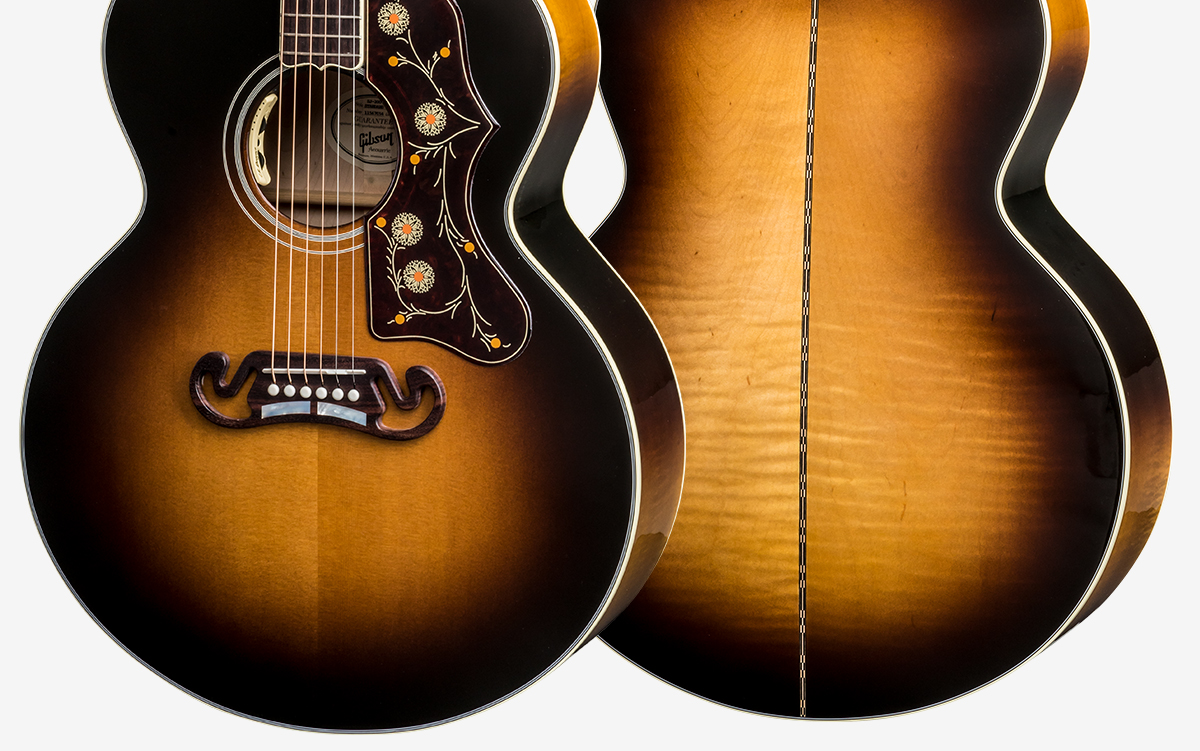

The SJ-100 had the maple neck and ebony fingerboard of the SJ-200, but with pearl dot inlays instead of the 200’s crests. The SJ-100’s back binding was single-ply, but it, too, was extra thick. 05″, its wide white layers outlined the body with a stronger visual effect than the seven thin plies. Not only did it surpass the SJ-200’s binding in thickness by about. The top binding on the SJ-100 was only three-ply, compared to seven-ply on the SJ-200, but the SJ-100’s binding was unusually thick – around 0.25″ thick. The SJ-100’s pickguard did not have the engraving of the SJ-200, but it did have its own distinct shape, recognizable by a sort of scalloped feature on the upper edge. Early examples of both models had individual height-adjustable bridge saddles. The SJ-100’s bridge was the same open-ended moustache shape that the SJ-200 sported, but without the long blocks of inlaid mother-of-pearl.

In ’39, when the model was first cataloged, a second super jumbo-sized guitar made its debut the SJ-100 had mahogany back and sides, and though its price was only half of the SJ-200, it was still higher than other Gibson flat-tops (the Advanced Jumbo and the Nick Lucas Special), and it had features to justify the price. It featured back and sides of rosewood – then, as now, the premium tonewood for flat-tops. Gibson began making the SJ-200 on a custom basis (initially just called Super Jumbo) in ’38. They were only 1″ wider than Gibson’s dreadnought-size flat-tops, but they appeared even larger thanks to their circular lower body shape. Both models were the same size – 17″ wide across the lower bout – and shaped like the “advanced” (widened) L-5 Gibson introduced in 1935. The lack of attention garnered by the SJ-100 began with its introduction in 1939, in the shadow of the SJ-200. While the SJ-100 did not have the degree of ornamentation of the higher model, it nevertheless had its own distinctive sound and – as these two SJ-100s show – its own distinctive look, as well. Since the model numbers reflected list prices – $100 and $200, respectively – Gibson seemed to be saying that SJ-200 was twice the guitar that the SJ-100. In aesthetics, as well as performance, it should be ranked among Gibson’s most noteworthy models.Īs its name suggests, the SJ-100 occupied a place significantly below the SJ-200. The Super Jumbo 100, on the other hand, is one of Gibson’s more obscure models – a status it does not deserve. The Super Jumbo 200 is Gibson’s most celebrated flat-top model, and deservedly so, thanks to its use by cowboy movie stars in the pre-World War II years and by country music stars in the post-war years. (LEFT TO RIGHT) 19 Gibson Super Jumbo 100.


 0 kommentar(er)
0 kommentar(er)
